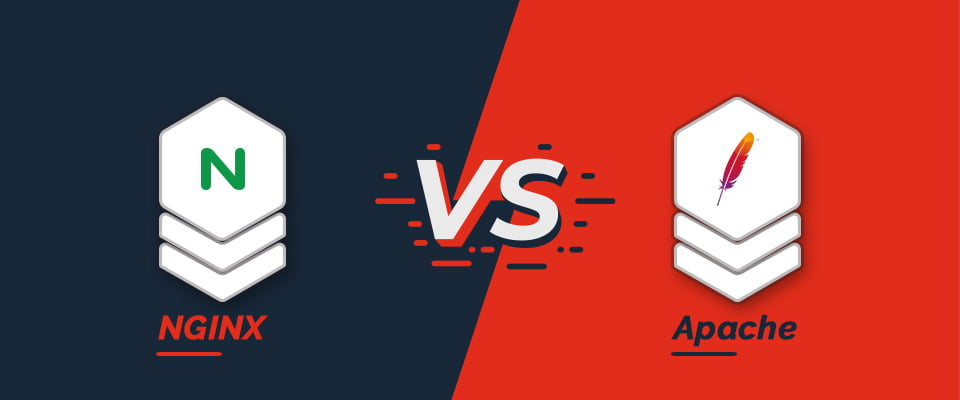
Internet, the way we understand it today, began its worldwide “conquest” in the ’90s. The entire “Web” protocol can be described as a user seeking a document via an address on the internet, using a DNS as well as an IP system forwarding the request to the correct computer. The computer hosting the web page can “serve” the web page and return the page to the visitor.
Web pages are HTML documents. To serve various web pages to people who visit them your “serving” machine needs server software. Software such as Nginx and Apache handles requests, examines them, and finally hands the relevant documents back for viewing by the user’s browser.
Differences Between Apache and NGINX

In comparing Apache and NGINX, there are six criteria that can be used to evaluate their differences. It is important to note that both web servers have their own unique advantages, and this comparison aims to highlight those differences.
Simplicity
Apache is known for its simplicity in the development process. It allows developers to insert code in a way that, if it fails, only the worker processes running the code will be impacted while all other connections remain unaffected.
NGINX, on the other hand, has a more advanced architecture, which can make module development more challenging. NGINX module developers must ensure their code is reliable and error-free in order to be compatible with the complex kernel and avoid blocking operations.
Performance

The performance of Apache and NGINX is determined by how efficiently the server is able to deliver large amounts of data to the user’s browser. This is especially important when dealing with dynamic or static content.”
Static Content
NGINX is generally more efficient than Apache when serving static content. Tests have shown that it is 2.5 times more efficient than Apache when handling up to 1,000 concurrent connections and is twice as fast and uses less memory in another test with the same number of simultaneous connections.
Dynamic Content
For dynamic content, NGINX and Apache perform equally well according to benchmark tests by Speedemy. This is because most of the time spent processing requests for dynamic content occurs within the PHP runtime environment, which is similar in both web server environments.
Apache can handle dynamic content by integrating a language processor, such as PHP, into each worker instance. This allows it to process dynamic content on the web server without relying on external components. Dynamic processors can be activated using dynamically loaded modules.
NGINX, on the other hand, does not have the ability to handle dynamic content internally. It must send requests for dynamic content, such as PHP, to an external processor to be executed and wait for the resulting content to be returned. This approach has some advantages, such as the interpreter only being activated for dynamic content and not being a part of the worker’s process.
OS Support
Apache is a cross-platform web server that can be run on various operating systems including UNIX, Linux, BSD, and Microsoft Windows. It is fully supported on Windows and performs well on other platforms as well.
NGINX is also compatible with a range of Unix-like systems, including Windows. However, its performance on Windows may not be as stable as it is on UNIX platforms.
Security

The two servers Apache along with NGINX are safe web servers. Apache Security Team Apache Security Team is a team that offers assistance and guidance to Apache projects regarding security concerns and coordinates the management of security weaknesses.
It is crucial to set up the servers correctly and understand what each setting accomplishes. There are numerous tips to protect servers from security attacks.
Flexibility
The Apache and NGINX web servers can be modified by adding additional modules. Apache has a long history of running dynamic modules, which can be customized to support this feature.
NGINX Plus is a software load balancer, web server, and content cache built on the open-source NGINX platform. It has an open architecture that allows new features and functions to be added via software modules that can be integrated into an active NGINX Plus instance on demand. These dynamic modules provide additional functionality, such as geo-locating users based on their IP addresses, resizing images, and embedding Lua scripts in the NGINX Plus event-processing model. The modules can be developed by NGINX or third-party programmers.
Both Apache and NGINX provide core module functions such as caching and proxy load-balancing.
Support and Documentation
When choosing a web server, it is important to consider the level of support and documentation available. Apache has a long history and widespread support, with a large library of first- and third-party documentation available for the main server and scenarios where Apache is connected to other programs.
Many tools and web-based projects also have tools for setting up in an Apache environment, which can be found in the projects themselves or through the software maintained by the distribution’s packaging team. Apache generally receives more support from third-party developers due to its widespread use and long history.
In the past, NGINX had limited English-language documentation, as most of the development and documentation was in Russian. However, the documentation has improved over time and there are now many administration resources available on the NGINX website and from third-party sources.
Apache

We’ll start with Apache first since it was first released. Following Tim Berners-Lee’s CERN HTTPd and NCSA HTTPd during the beginning of the age on the web, Apache – first introduced in 1995 – quickly gained ground and became the most well-known web server.
Today, it is at the top of the list, but mostly because of its history. Apache is created and is maintained under the Apache Foundation as part of its Apache license.
There are two theories regarding how Apache came to be named. One story claims that the name comes from the famed Native American heritage. In contrast, another version claims Apache is a reference to “a patchy server” resulting from software patches.
Linux

Apache’s market share is partly due to its being pre-installed on most Linux distributions like Red Hat/Centos and Ubuntu.
One of the most significant significances of Apache in Apache’s role within the Linux world is that the name of its server process is HTTPd which makes Apache an acronym for internet server applications.
In addition to being the initial major player in the market for web servers, The reason Apache has grown so rapidly can be attributed to the configuration process and its .htaccess file.
.htaccess
Apache makes use of .htaccess for its configuration. There are a lot of tutorials on how to set up, edit, modify, and use this file, as it gives lots of flexibility when the way that Apache handles requests that come in.
Examples include various redirection rules as well as maximum upload file size, URL rewrites, memory limits, and security for directories (htpasswd) and expires headers and cache-control headers, as well as cookies, encoding headers, and cookies and queries string manipulators.
However, the settings and rules in your .htaccess files are simply “translated” to Nginx’s own rewrite rules syntax.
One of Apache’s major “Pros” is that it is a server’s root directory — which is the principal directory for websites — each level or directory within the directory tree can have its .htaccess file, with its configuration.
For hosting companies that offer shared hosting it is an ideal solution since they can offer hundreds of users sharing the same server the ability to alter how their websites are served without impacting the other.
Customers can alter several pieces of information in a shared hosting environment but not affect the server’s global configuration.
However, this flexibility can hinder speed ” permitting .htaccess files causes a performance hit, whether or not you even use them!”
When the .htaccess files have been enabled, Apache needs to go through all the directory trees beginning with the URL requested or file to upper levels until it reaches the server’s root directory, and then load them for every request. Then, it must handle these files and modify itself to each directory configured this way.
With WordPress websites, it can become quite complicated. The typical WordPress website could receive many requests coming from various directories.
When loading a WordPress website, it is common for multiple requests to be made for static resources from different directories, such as /wp-content/uploads/yyyy/mm, /wp-content/themes/parent-theme, /wp-content/themes/child-theme (including javascript, CSS files, and images), and /wp-content/plugins with static files from various plugin subdirectories.
Each of these requests requires Apache to search through the entire directory tree to find the appropriate configuration, as specified in the .htaccess file.
A study found that a typical WordPress configuration, common in shared hosting environments, involves 42 distinct .htaccess executions and 249 searches for a .htaccess file.
This is just at the web server level and does not include the time required for a PHP process to run the complete WordPress call stack and build the database query, which is then given to MySQL to create the website page and send it to the visitor.
Modules
One of the factors contributing to Apache’s popularity is its flexible module system, which allows users to expand the functions of the web server. Both Apache and NGINX have module systems that enable this capability.
Apache allows users to install modules after the server has been deployed and installed and then enable or disable them using the A2enmod and A2dismod commands. These commands are available on Debian-based distributions and allow users to enable and disable modules without modifying the configuration files.
Nginx

NGINX was first introduced in 2004 by Russian software developer Igor Sysoev and was designed specifically to address the performance limitations of Apache web servers. It was initially developed as a scaling tool for the site rambler.ru in 2002 and is available in open-source and Nginx Plus versions.
When it was first released, NGINX was mostly used for serving static files and as a load balancer or reverse proxy for Apache installations. However, as the demand for speed and efficiency increased, more websites began replacing Apache with NGINX, including mature software. According to data for all web servers worldwide, NGINX has a presence among the top 1 million websites.
Nginx Configuration
Nginx is not an administration system similar to Apache, which is why, despite being much faster and more efficient, it’s not extensively used by retailers hosting companies. It is not as effective in shared environments as Apache does.
However, it is true that by not allowing directory-level configurations Nginx has a distinct advantage over Apache.
Nginx Modules
The Nginx module system is just another thing that sets it up as a premium option. Nginx modules are typically required to be turned on when building. This means a higher level of technical proficiency is required, and the subsequent installation of modules can be more difficult.
In 2016, with the release of version 1.9.11, things changed, and the verified dynamic module repository was made available for paid users. In May, they announced that they were launching the support of QUIC and HTTP/3.
The Matter of Caching: Nginx vs Apache

Caching is a technique used to prepare website content in advance so that it can be quickly retrieved when a visitor requests it. This helps to reduce the burden on other infrastructure and can be thought of as having the information already prepared and ready to be handed to the visitor as soon as they request it, rather than having to search for it first.
Both NGINX and Apache can use caching to store static content and reduce the need to retrieve it from the source server each time. NGINX also has the ability to use dynamic caching, also known as page caching, which involves storing all WordPress pages in the memory of the disk for a website.
Apache has the mod_cache module for caching, but it is known to be unreliable and may conflict with other modules. As a result, Apache’s most popular caching solution is the Varnish HTTP accelerator. However, recent tests have shown that NGINX caching may be superior to Varnish.
Handling Requests: Nginx vs Apache

The key difference between Apache and NGINX lies in the way they handle requests. Apache processes requests using Multi-Processing Modules (MPMs), which are responsible for binding to network ports on the machine, accepting requests, and dispatching children to handle the requests.
The oldest MPM, known as the Prefork Module, dates back to the inception of Apache and is known for causing Apache’s reputation for poor performance. In this mode, Apache creates a new process and thread for each request, leading to inefficiency. Apache later developed the worker MPM, which is multi-threaded, and the event-based MPM, which helped to improve performance. However, NGINX uses an event-driven, non-blocking architecture that is synchronous and non-blocking.
This means that NGINX uses a single worker process for each core/CPU and can handle many thousands of connections to networks for each worker, without the need to create threads or processes for each connection. This is why NGINX is essential for content delivery networks like Cloudflare and MaxCDN, as well as companies like Netflix and Automattic, the private company behind WordPress.com.
Checking It in Real Life
To check which web server a website is using in production, we can look at the HTTP response headers. To do this, we can right-click on the website, select the developer tools, go to the network panel, and load the site. We will see a list of resources that the site is loading.
If we click on a specific resource and go to the Headers tab, we will often see the server information. If the website uses a content delivery network (CDN), the server line may show something like Cloudflare or an HTTP accelerator like Varnish. For example, the following image shows a WordPress site using a typical shared hosting configuration with cPanel, Apache, and PHP:
On the left, we can also see the load time of each resource and assess its impact on the overall loading time.
Performance Comparison – Static vs Dynamic Content

A web server’s performance is generally defined by its capacity to manage dynamic and static content. Static content refers to any web content that is the same each time it’s sent to an end-user. It’s typically stored in the form of a CDN server.
Therefore, it doesn’t change and doesn’t have to be dependent on the user’s behavior, making it one of the easiest kinds of content to transfer on the internet. Some examples of static files include JavaScript library HTML and CSS files and images.
Dynamic content is a webpage or file that is modified according to the user’s needs and preferences, traits, and characteristics. It won’t be the same for everyone, as it’s created by a user who requests an online page. A few examples of websites with this type of content are websites that sell products online and social media sites.
Because NGINX and Apache offer different ways of dealing with requests for dynamic and static content, let’s find out which one is more efficient in this Apache contrast versus NGINX comparison.
Security through Apache and NGINX

It is essential to choose a dependable and secure web hosting service that keeps your website’s information safe and updated regularly with the most recent updates.
Apache
Apache Software Foundation is actively working to resolve any security concerns related to its software to ensure that Apache HTTP is secure. Apache HTTP server is safe.
Users can sign up for the Apache Server Announcements mailing list to be updated on the latest security updates from the team responsible for software development.
Apache also comes with a few configuration options that may help manage denial-of-service (DoS) attacks, like:
- TimeOut – It is the number of minutes Apache will sit for certain occasions before rejecting the request. Websites that are vulnerable to DoS attacks must limit this amount to as low as only a few seconds.
- RequestReadTimeout – It shuts down connections for clients who don’t make their requests available quickly enough.
- KeepAliveTimeout- Determines how long it takes for the Apache server will sit and maintain the open connection for new requests.
Remember that while Apache is designed to be stable and secure, the security of your server depends on the way you configure the server. So, you should consider taking other security steps, for example, installing a Web Application Firewall (WAF).
NGINX
NGINX provides a variety of security features that are available out of the box. A key one is rate-limiting which limits the rate of requests received to the typical rate for actual clients.
It also assists in protecting the server against DDoS attacks. NGINX rate-limiting also shields upstream application servers from having too many requests at once.
Additionally, NGINX users can prevent DDoS attacks by allowing or denial of access to clients based on their IP addresses. This access may also be restricted through passwords, which are the consequence of subrequests or bandwidth.
Furthermore, NGINX supports the newest transport layer security (TLS) version, which offers secure encryption for data transmitted through the internet.
To gain additional security features, think about the use of NGINX Plus. With this version of NGINX Plus, you’ll be able to access SSO or the one-sign-on (SSO) function that allows users to securely authenticate on numerous websites and applications using the same pair of passwords.
Additionally, NGINX users can go to the official website of this open-source server to get additional security alerts as well as news regarding the most recent security update.
Choosing a Web Server

After examining the differences between NGINX and. Apache, it’s clear that each program has benefits and disadvantages. Therefore, it’s important to be aware of one’s needs before choosing between NGINX and Apache.
Apache is perfect for shared hosting environments. It gives access to the root user to edit the configuration file that is the primary one and allows non-privileged users to control certain aspects of the server. The drawback is that this software could take up a significant amount of server memory.
In the case of NGINX, its performance is superior to Apache’s in handling requests for static content. It can also handle multiple clients at a time when there is a lot of traffic, making it a great option for sites with a significant traffic flow.
Furthermore, NGINX is multi-functional – users can utilize it as a reverse proxy or load balancer and a caching system. However, the software cannot provide dynamic content as a default and needs to redirect all requests for dynamic content to an application server at the back end.
Keep in mind that there are a variety of more popular servers you can pick from, some of which may have more than Apache and NGINX provide specifically. There are a few, such as Tornado, Node.js, and Tomcat.
Can Apache and NGINX Work Together?
It is feasible to use NGINX and Apache together and use each server’s strengths. NGINX for its high processing speed, and Apache for its robust modules.
The usual practice when using both programs is to use NGINX to act as an intermediary in front of Apache because it can handle hundreds of connections simultaneously.
As a proxy front end of Apache, NGINX will handle every request from clients. For instance, if it receives requests from a static website, NGINX will serve the files directly to the user.
As a reverse proxy server for dynamic content NGINX forwards requests to Apache, which will process the request and then transfers all the content back to the user via NGINX.
Utilizing Apache or NGINX can lessen the blockage that can occur when an Apache process or thread is busy, thereby increasing the performance of your server.
Frequently Asked Questions
Is Apache superior to NGINX?
Regarding performance, NGINX is much better than Apache. NGINX is 2.5 times more efficient than Apache and uses less memory. Apache indeed offers more features and functionality. It is important to note that you can combine both.
Are Apache and NGINX the Same?
It’s not true. Apache and NGINX are not identical. Both are open-source web servers. However, Apache is an HTTP server, and NGINX can function as the reverse proxy server.
Can NGINX Replace Apache?
It’s unlikely. Although NGINX has more efficiency, NGINX doesn’t include Apache’s configuration system, and both offer advantages and drawbacks.
Why is NGINX more efficient than Apache?
The design of NGINX is more capable of handling large static files. It doesn’t need context switches, so one thread can handle all requests.
Can PHP Run on NGINX?
Yes, you can run PHP on NGINX. You can find the installation instructions on the internet.
Is Apache Still Used?
Apace indeed continues to be widely utilized. It is still one of the most used web servers.
Does Facebook Use Apache or NGINX?
Neither. Facebook utilizes a custom server they created themselves and is running on Linux.
Summary
In this post, we concentrated on Nginx compared to Apache. We reviewed the primary architecture differences that contributed to Nginx getting more attention and recognition within the realm of the web server.
These main characteristics provide it with an edge in the resource-hungry market. Of course, not every situation has the same requirements as well. Was this guide helpful for you or not? Let us know by sounding off in the comment section below. In case you have any doubts then tell us.
